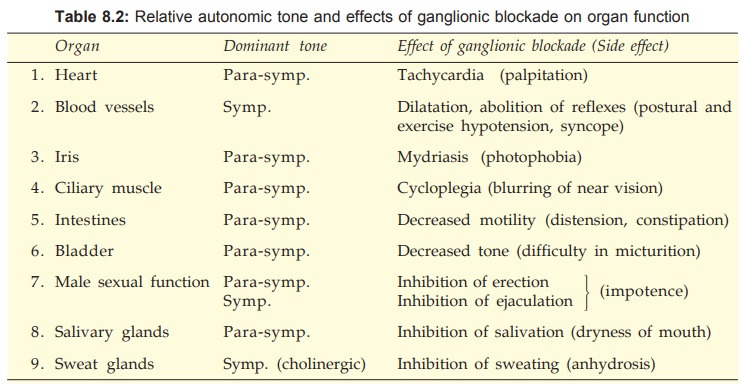Drugs Acting on Autonomic Ganglia
| Home | | Pharmacology |Chapter: Essential pharmacology : Anticholinergic Drugs And Drugs Acting On Autonomic Ganglia
Acetylcholine is the primary excitatory neurotransmitter in both sympathetic and parasympathetic ganglia. Drugs which inhibit synthesis (hemicholinium) or release (botulinus toxin, procaine) of ACh can interfere with ganglionic transmission, but drugs which act on cholinergic receptors in the ganglia are more selective.
DRUGS ACTING ON AUTONOMIC GANGLIA
Acetylcholine
is the primary excitatory neurotransmitter in both sympathetic and parasympathetic
ganglia. Drugs which inhibit synthesis (hemicholinium) or release (botulinus
toxin, procaine) of ACh can interfere with ganglionic transmission, but drugs
which act on cholinergic receptors in the ganglia are more selective.
In
addition to the dominant nicotinic NN receptors, which mediate the
primary rapid depolarization of ganglionic cells, there are subsidiary
muscarinic M1, M2, adrenergic, dopaminergic, amino acid
and peptidergic receptors which bring about secondary, slowly developing but
longer lasting changes in membrane potential, both positive and negative, that
modulate the primary response. Separate catecholamine (NA, DA) and amino acid
containing cells are present in ganglia, but peptides are released from the
preganglionic cholinergic terminals themselves. Thus, autonomic ganglion is not
merely a one transmitter—one cell junction, but a complex system capable of local
adjustments in the level of excitability.
Drugs can either
stimulate or block the ganglia.
Ganglionic
stimulants
Selective nicotinic Nonselective/muscarinic
agonists agonists
Nicotine (small dose) Acetylcholine
Lobeline Carbachol
Dimethyl phenyl Pilocarpine
piperazinium (DMPP) Anticholinesterases
iodide MCN 343A
Tetramethyl ammonium
(TMA)
Nicotine (from Nicotiana tabacum) is important in the context of smoking or chewing tobacco,
but there is no clinical application of ganglionic stimulants, because no
useful purpose can be served by stimulating both sympathetic and
parasympathetic ganglia concurrently.
Nicotine transdermal has recently become available for treatment of nicotine dependence
and as an aid to smoking cessation. It ameliorates the symptoms of nicotine
withdrawal, but does not completely suppress craving, because the peak nicotine
blood levels that occur after smoking are not reproduced by the patch.
NICOTINELLTTS
10, 20, 30 cm2 patches releasing 7, 14, 21 mg nicotine per 24 hr respectively.
In
those smoking >20 cigarettes every day—start with 30 cm2 patch, shift to
smaller patches every 5–8 days, treat for 3–4 weeks (max. 12 weeks). Headache,
insomnia, flu like symptoms, dyspepsia, loose motion and local irritation are
the side effects. Cardiac arrhythmias and ischaemic heart disease are the
contraindications.
Varenicline This NN subtype nicotinic
receptor partial agonist is under
clinical development for smoking cessation. Controlled trials have found it to
reduce craving as well as nicotine withdrawal symptoms in those who stop
smoking. Abstinence rates after one year were higher than placebo and
comparable to bupropion (see No. 33).
Rimonabant A selective cannabinoid receptor1 (CB1) antagonist which is being tried as antismoking
and anti-obesity drug. It appears to have the potential to help smoking
cessation as well as maintain smoking abstinence.
Ganglion blocking agents
A) Competitive blockers
Quaternary ammonium
compounds Hexamethonium,Pentolinium
Amines (secondary/tertiary) Mecamylamine,
Pempidine
Monosulfonium compound Trimethaphan
camforsulfonate
B) Persistent depolarising
blockers
Nicotine (large dose)
Anticholinesterases (large dose)
The competitive
ganglion blockers were used in the 1950s for hypertension and peptic ulcer, but
have been totally replaced now because they produce a number of intolerable
side effects (see Table 8.2). In
fact, these side effects help in understanding the relative roles of sympathetic
and parasympathetic divisions in regulating the various organ functions.

Trimethaphan It is an ultrashort acting ganglion blocker; has been occasionally used to produce
controlled hypotension and in hypertensive emergency due to aortic dissection.
Mecamylamine alone, as well as in combination with nicotine
patch, has been tried for smoking cessation. It appears to block the reward
effect of nicotine and improve abstinence rate compared to placebo. Constipation
occurred in many subjects, and it is not an approved drug.
There is at present no
clinical relevance of ganglion blockers.
Related Topics
